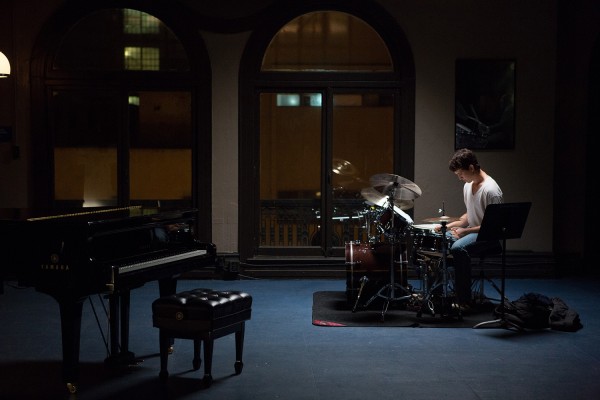“I am the worst thing since Elvis Presley/ To do black music so selfishly/ And use it to get myself wealthy” — EminemIn a typically self-aware move, the rapper Eminem uses the above line in his song “Without Me” to preempt charges of appropriation, while also bragging of his proficiency in the style he’s appropriating. The line would come across as insufferable nonsense if it weren’t for the truth of the latter claim—“Without Me” is a good rap song. Eminem appropriates forms that were cultivated by African American musicians, acknowledges it, and attempts to justify his borrowing through delivering impeccable takes on them.
By contrast, two recent films, Jimi: All Is by My Side and Whiplash, use African American music to tell their stories, but they approach them without the same understanding. As a result, the use of music in both films comes across as hollow opportunism—an attempt to reap the benefits of audience associations with the music without coming from a place of genuine knowledge or sensitivity. Even worse, the mediocre presentation of the music presents viewers unfamiliar to it in its original form with a watered-down version that doesn’t allow them to experience its true artistic value.
All Is by My Side is a recent biopic of the legendary guitarist Jimi Hendrix. There’s music heard throughout it, but none of it is actually Hendrix’s. His estate denied permission for the filmmakers to use any of his music, so the soundtrack is instead saddled with covers of songs covered by Hendrix, other songs deemed to be thematically appropriate, and the occasional piecemeal blues lick. Though it’s challenging to imagine a film doing justice to Hendrix’s legacy without including any of his original music, All Is by My Side fails spectacularly in the ways in which it tries to compensate. Furthermore, its attempts all feel guided towards diluting the African American influence of the music it represents.
Though the choice of covers in the film is limited by the songs Hendrix actually covered, their presence serves to exaggerate the impact of white musicians on his music. Over the course of the film, Hendrix stand-in André Benjamin, known more commonly as André 3000, sings “Wild Thing,” “Sergeant Lonely Pepper’s Lonely Hearts Club Band,” and “Hound Dog.” These three songs all share the distinction of being songs heavily influenced by African American music, but written and originally performed by white artists. The most egregious example of these is “Sergeant Lonely Pepper’s Lonely Hearts Club Band,” which is performed and ludicrously presented as a creative zenith for Hendrix, but the use of all three songs suggests that the guitarist was much more indebted to white musicians than history—and his music—indicates.
The trend continues in the rest of the film’s soundtrack. As with the covers, it’s populated primarily by white musicians appropriating the blues: Namely Bob Dylan’s “Leopard Skin Pill-Box Hat” and The Animals’ “House of the Rising Sun.” Though these songs help illustrate the landscape of the period in which Hendrix was coming up, they serve to make the blues seem like a genre dominated by white people. Outside of T-Bone Burnett, not much is heard from black artists like Muddy Waters and B.B. King, who managed to commodify the music of their culture. All Is by My Side shows the history of Hendrix’s blues as being indebted to whites, while it simultaneously ignores the guitarist’s importance as a black artist.
Things don’t get much better in Whiplash. The film tells the story of a young jazz drummer named Andrew (Miles Teller) studying in a prestigious music conservatory under the tutelage of the great but abusive conductor, Terence Fletcher (J.K. Simmons). The boy gets mocked, insulted, and physically beaten by his teacher, all in the name of pursuing artistic greatness. The problem lies in just what sort of greatness the two are trying to pursue: The film refers to it as “jazz,” but what’s depicted onscreen shows otherwise.
The film represents jazz as being about physicality rather than musicality. Andrew is shown playing actual music at times—most notably in the film’s final scene—but he’s seen much more frequently bashing away at his drum set, striving to perfect his technique at the expense of working on anything else. Fletcher encourages Andrew’s obsession with technical perfection through his constant goading and demands.
This could make sense in a film about sports, but not in a film about jazz—or really any sort of music. It’s not hard to imagine a young music student with Andrew’s mentality (I once had it myself), but anyone who’s been around the music for a bit longer understands that it can’t be learned strictly through the approach shown on screen. However, Whiplash reveals Andrew’s focus on technique to be an effective way to go about studying jazz.
Writer-director Damien Chazelle ultimately appears to be unconcerned by this, as his primary goal is to tell his story of a teacher-student relationship. In the process of his storytelling, he uses jazz without respecting or understanding the music, thus leading to unconvincing appropriation. As with All Is by My Side, the film uses a form of African American music without accurately depicting it on screen. In providing viewers with these weak and inauthentic representations of the music, both filmmakers discourage audiences from recognizing its beauty.








